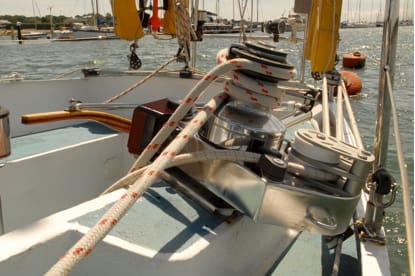Most wind-driven self-steering gear is based on stern-mounted wind vane setups. There are various combinations of servo-pendulum and auxiliary rudder models available that are installed aft of the cockpit and provide input to control lines that steer the boat based on a set angle to the wind.
English inventor Rob Chicken has has taken a different approach to wind-powered self-steering, however. His product is called the Steersman and it makes use of the genoa in the bow as the wind vane and a mechanical unit attached to a cockpit winch to supply the steering motion to the helm. This new approach won the U.K. Haven Academy 2012 award for innovation. Chairman of the judging panel was Sir Robin Knox-Johnston, a guy who knows something about self-steering gear.
According to Chicken, the Steersman works like this: "The system consists of two units, each positioned on the cockpit coamings just astern of the jib sheet winches. These units are allowed to swing fore and aft about a pivot point built in to the cockpit side of the unit. A turning block on the front of each unit guides the genoa sheet to the winch, and shock-cord spring is stretched between the stern end of the unit and some point at the stern of the boat.
"When sailing, the jib sheet on the leeward side of the boat is tensioned up as normal, then the spring is tensioned up to balance the pull. When roughly balanced, the lock is released, and the spring is then finely tuned. At the stern of the unit is a short pole, with a simple fitting at the end. To complete the set-up, the steering pole is dropped in to place to connect from the end of the short pole to a similar fitting attached to a spoke on the wheel.
"The spring consists of a length of shock cord fed through a double block at the stern end (usually attached to the pushpit), and a single block at the forward end which together with the ‘cord-fixed-end’, and the ‘cord-free-end’ are attached to the unit. The ‘cord-free-end’ is then fed through a jamb cleat which is fitted to the top of the unit and is used to adjust the tension. With these in place, there are now 4 lengths of shock cord which make up the spring. To reduce the spring tension for lighter winds, the single block and ‘cord fixed-end’ can be moved to a ‘keeper eye’ fitted in the base of the unit. This re-positioning provides a variation in spring size from four cords down to one. For lighter winds, this whole arrangement is abandoned, and a single lighter shock cord is fitted in its place."'
Chicken says there are some distinct benefits to the Steersman, such as: reacting instantly to wind pressure changes; operating from close hauled to 160 degrees off the wind; the whole assembly being inside the cockpit, leaving the stern clear for boarding ladders, davits, etc.; it can be used on tiller-steered or wheel-steered boats.
The Steersman is definitely a different approach to wind-powered self-steering. You can read more at the Steersman website.

